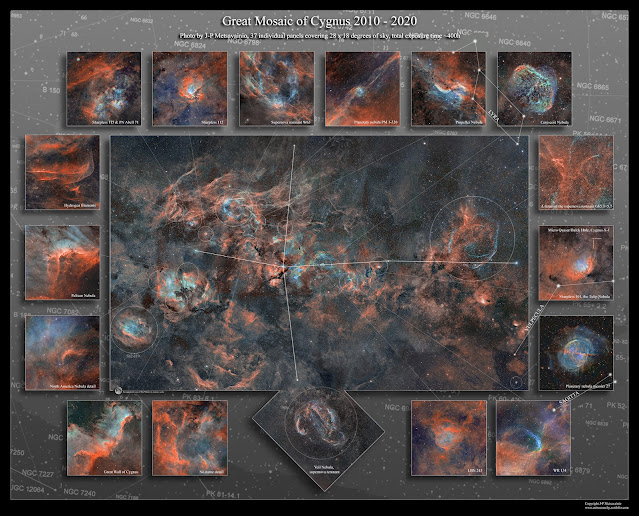COPYRIGHT, PLEASE NOTE
Thursday, February 11, 2021
APOD by NASA, Astro Anarchy gets published
Monday, February 8, 2021
Cygnus mosaic in visual colors
I have published this image in mapped colors at December 2020, it can be seen here, https://astroanarchy.blogspot.com/2020/12/cygnus-project-grande-finale-for-now.html
I have started this imaging project back at 2010. My aim was to make a high resolution mosaic covering the constellation Cygnus. Work like that takes time and patience, especially since I have worked so, that many of the individual sub mosaics or frames have been published as an individual artworks. Here is a poster format presentation about all of longer focal length images used for this mosaic beside wide field panels, https://astroanarchy.blogspot.com/2018/11/treasures-of-swan.html
As a result I have now a huge 37 panel (And 58 long focal length sub-panel) mosaic panorama covering 28 x 18 degrees of sky. I have collected photons way over 400 hours during past ten years for this photo. The full size mosaic image has a size of about 25.000 x 15.000 pixels.
A photo of five million stars*
Great Mosaic of Cygnus (2010-2020)
28x18 degrees, 97 panels and over 400 hours of exposure time
The full size photo is worth to see! (2700 x 1700 pixels) An apparent size of the Moon is marked as a scale at bottom left of the picture frame.
An apparent size of the Moon is marked as a scale at bottom left of the picture frame.
This is a large area of sky! (28 x 18 degrees) Image is in visual colours, from the emission of ionized elements in the area.
* I actually counted the stars and in this field of view there are little over five million individual stars!
Three supernova remnants, two Wolf Rayet stars and a black hole
Please, click the image for full resolution
Beside three supernova remnants there are two Wolf Rayet stars with outer shell formations. NGC 6888, the Crescent Nebula at center of the image and the WR 134, it can be seen as a blue arch just right from the Crescent Nebula, near the Tulip nebula.
Next to the Tulip Nebula lays a Black hole Cygnus X-1, it's marked in small closeup image of the Tulip Neula at center right in orientation image above.
Constellation Cygnus is an endless source of celestial wonders, both scientifically and aesthetically. For me, as an visual artist, this are of night sky is very inspiring There are endless amount of amazing shapes and structures, I can spend rest of my life just shooting images from this treasury.
Click for a large image
Here is a poster format presentation and a list all of longer focal length images used for this mosaic beside the actual panels, https://astroanarchy.blogspot.com/2018/11/treasures-of-swan.html
Couple of close ups to show the resolution
Click for a large image
Monday, February 1, 2021
This gigapixel mosaic has about 1000 exposure hours between 2010 - 2021
Over a ten years and about 1000 hours of exposures, the image spans 82 x 20 degrees of sky at resolution of 17.000 x 72.000 pixels (Over a gigapixel)
Individual frames are shot between 2010 and 2021, there are total 168 images stitched together! There are more than ten million stars visible in this mosaic image!
Orientation in the sky
Click for a large image
My processing workflow is very constant so very little tweaking was needed between the mosaic frames. Total exposure time is way over 900 hours. Some of the frames has more exposure time, than others. There are some extremely dim objects clearly visible in this composition, like a extremely dim supernova remnant W63, the Cygnus Shell. It lays about six degrees up from North America nebula and it can be seen as a pale blue ring. I spent about 100 hours for this SNR alone. An other large and faint supernova remnant in Cygnus can be seen at near right edge of the image. G65.5+5.7 is as large as more famous Veil nebula. There are over 60 exposure hours for this SNR alone. (Veil SNR is just outside of the mosaic area but can be seen in "Detail" image above.)
The supernova remnant G65.3+5.7
A closeup from the supernova remnant G65.3+5.7
The noise is not a noise, just a massive amount of stars
The blog post with technical details can be seen here, https://astroanarchy.blogspot.com/2020/10/the-tulip-nebula-in-cygnus-sh2-101.html
Cirrus of Cygnus and the supernova remnant W63
Blog post about this photo, https://astroanarchy.blogspot.com/2020/12/cirrus-of-cygnus-and-supernova-remnant.html

































